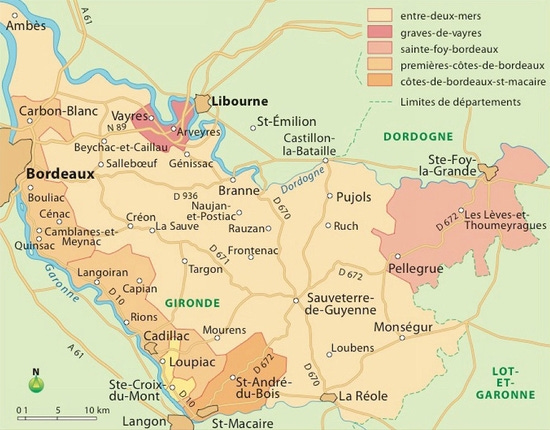Entre-Deux-Mers, meaning “between two seas,” sits between the Garonne and Dordogne rivers and is Bordeaux’s main appellation for dry white wines. Known for its fresh and aromatic whites, this appellation is dominated by Sauvignon Blanc, with Sémillon and Muscadelle often blended to add complexity and body. Entre-Deux-Mers offers wines that are vibrant, easy-drinking, and versatile, making them a great introduction to Bordeaux whites and an excellent pairing choice for a variety of dishes. These wines are typically enjoyed young, showcasing crisp fruit flavors and refreshing acidity.
Primary Grape Varieties
Sauvignon Blanc provides lively acidity, citrus notes, and herbal aromas.
Sémillon adds body, roundness, and flavors of stone fruit and honey.
Muscadelle offers floral and grapey notes, adding aromatic lift to the blend.
What Makes Entre-Deux-Mers Special
Ideal Climate for Fresh Whites The area’s proximity to the rivers creates a slightly cooler microclimate, which helps retain acidity in the grapes and preserves the wines’ freshness. The terroir of clay-limestone and sandy soils also contributes to the clean, mineral character typical of Entre-Deux-Mers whites.
Accessible and Affordable Entre-Deux-Mers wines are some of Bordeaux’s most accessible and affordable offerings. These whites are crafted for immediate enjoyment, with a crisp, refreshing style that makes them ideal for casual sipping or pairing with seafood, salads, and lighter dishes.
Tasting Notes for Blind Tasting
Entre-Deux-Mers wines typically show notes of citrus (lime, grapefruit), green apple, and white flowers, with hints of grass or herbs. The wines are light-bodied with a crisp finish, often with a touch of minerality.
Quiz Time
How does the terroir of Entre-Deux-Mers influence the wine’s acidity and freshness?
Why is Sauvignon Blanc the dominant grape in Entre-Deux-Mers whites?
Premium Subscriber Content: Behind the Bright Whites of Entre-Deux-Mers
Terroir Insights
Entre-Deux-Mers’ terroir is defined by its clay-limestone and sandy soils, which help retain moisture and contribute to the wines’ clean mineral finish. This soil type, combined with the area’s slightly cooler climate, encourages acidity retention in the grapes, resulting in wines with crisp, refreshing profiles.
Keep reading with a 7-day free trial
Subscribe to Daily Terroir: Exploring Wine Regions One Day at a Time to keep reading this post and get 7 days of free access to the full post archives.




